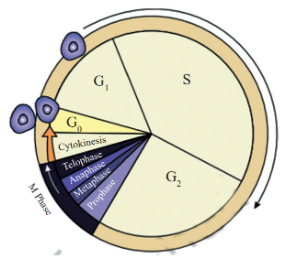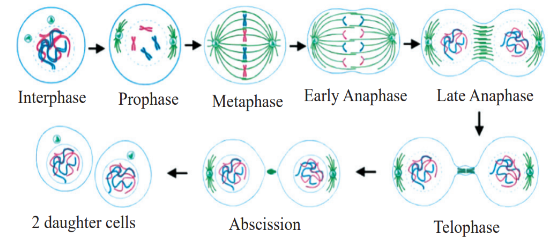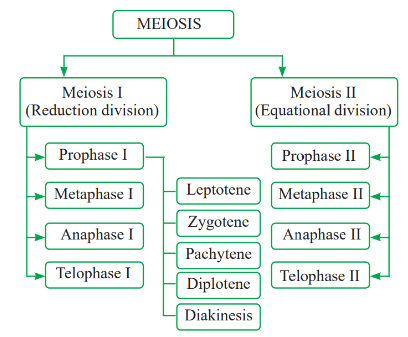
The cell cycle is the process through which a cell grows, duplicates its DNA, and divides into two new cells. It consists of different phases that help the cell prepare for division and ensure that everything is ready for the creation of two identical cells. Understanding the cell cycle is essential for biology students, especially for the NEET exam , as it helps explain how organisms grow and repair tissues. This topic is an important part of the NEET syllabus .
What is a Cell Cycle?
Cell division is essential for all living organisms. During this process, DNA replication and cell growth occur in a coordinated way to ensure proper division and the formation of progeny cells with intact genomes. The cell cycle refers to the sequence of events where a cell duplicates its genome, synthesizes cellular components, and divides into two daughter cells. While cell growth is continuous, DNA synthesis happens at a specific stage. The replicated DNA is then distributed to the daughter cells, and these processes are controlled by genetic factors.Phases of Cell Cycle
Cell division is essential for all living organisms. During this process, DNA replication and cell growth occur in a coordinated way to ensure proper division and the formation of progeny cells with intact genomes. The cell cycle refers to the sequence of events where a cell duplicates its genome, synthesizes cellular components, and divides into two daughter cells. While cell growth is continuous, DNA synthesis happens at a specific stage. The replicated DNA is then distributed to the daughter cells, and these processes are controlled by genetic factors. The cell cycle is divided into two basic phases:- Interphase
- M Phase (Mitosis phase)

Interphase
Interphase is the longest stage of the cell cycle where the cell grows, duplicates its DNA, and gets ready for division. It acts as the "preparation phase" before the actual cell division begins. Interphase is divided into three subphases: (I) G1 phase (Gap 1) (ii) S phase (Synthesis) (iii) G2 phase (Gap 2)- G1 phase (Gap 1) : The G1 phase is the interval between the end of mitosis and the start of DNA replication. During this phase, the cell is metabolically active, growing in size, and performing its regular functions, but it does not replicate its DNA.
- S phase (Synthesis): During the S phase, the process of DNA replication takes place. The amount of DNA in the cell doubles during this time. For example, if the initial DNA amount is 2C, it increases to 4C after the S phase. However, the number of chromosomes remains unchanged. If the cell had a diploid (2n) number of chromosomes before the S phase, it still has 2n chromosomes afterward. In animal cells, DNA replication begins in the nucleus, and the centrioles duplicate in the cytoplasm .
- G2 phase (Gap 2): During the G2 phase, the cell continues to grow and prepares for mitosis. Proteins essential for cell division are synthesized, ensuring the cell is ready for the mitotic phase.
- Quiescent Stage (G0): Some cells, such as heart cells in adult animals, do not divide and enter a quiescent (G0) stage. In this stage, cells remain metabolically active but stop proliferating unless required to divide, such as in the case of tissue repair.
Also Check:
M Phase
The M phase is the stage of the cell cycle when actual cell division, or mitosis, takes place. In the average 24-hour cell cycle of a human cell, cell division lasts for only about an hour, while interphase occupies more than 95% of the cycle. The M phase begins with the division of the nucleus, known as karyokinesis, where the daughter chromosomes are separated. This is usually followed by the division of the cytoplasm, called cytokinesis. Although interphase is often referred to as the "resting phase," it is actually a crucial period during which the cell grows and replicates its DNA in preparation for division. It comprises two primary processes: karyokinesis and cytokinesis . The karyokinesis phase of cell division includes four additional stages, which are:- Prophase
- Metaphase
- Anaphase
- Telophase

| Stage | Description | Key Events |
| Prophase | Prophase is the first stage of karyokinesis that occurs after the S and G2 phases of interphase. During interphase, DNA molecules are intertwined and not distinct. In prophase, chromosomal material begins to condense, and centrosomes move towards opposite poles. |
|
| Metaphase | Metaphase is characterized by the complete disintegration of the nuclear envelope, allowing chromosomes to spread throughout the cytoplasm. Chromosomes are fully condensed, making them clearly visible under the microscope. |
|
| Anaphase | Anaphase begins with the splitting of centromeres, allowing sister chromatids to separate. The separated chromatids, now called daughter chromosomes, move towards opposite poles of the cell. |
|
| Telophase | Telophase is the final stage of karyokinesis, where chromosomes reach the poles and begin to decondense, losing their distinct shape. A new nuclear envelope forms around each set of chromosomes, resulting in the formation of two daughter nuclei. |
|

Cytokinesis
Cytokinesis is the process by which the cytoplasm of a cell divides into two distinct daughter cells. This typically occurs alongside the formation of daughter nuclei following nuclear division. Cytokinesis varies between plant and animal cells. In some cases, cytokinesis may not follow karyokinesis, resulting in a multinucleate condition; such cells are referred to as coenocytes or syncytia.- Animal Cells : In animal cells, a shallow groove forms in the cytoplasm due to the contraction of microfilaments, which leads to cell division.
- Plant Cells : In plant cells, a structure known as the cell plate appears at the cell's equator, facilitating the division of the cell.
Significance of Mitosis
Mitosis, or equational division, primarily occurs in diploid cells, although some haploid cells in lower plants and social insects can also undergo mitosis. Understanding the significance of mitosis is crucial for appreciating its role in an organism's life. Here are the key points:- Production of Daughter Cells: Mitosis typically produces diploid daughter cells that have identical genetic material.
- Growth of Multicellular Organisms : Mitosis contributes to the growth of multicellular organisms. As cells grow, the ratio of the nucleus to the cytoplasm is disturbed, necessitating division to restore balance.
- Cell Repair: Mitosis plays a vital role in cell repair and regeneration. Cells in the upper epidermis, gut lining, and blood are continuously replaced through mitosis.
- Continuous Growth in Plants : In plants, mitotic divisions in meristematic tissues, such as the apical and lateral cambium, support ongoing growth throughout their lives.
Meiosis
Meiosis is a distinct form of cell division that takes place in organisms that reproduce sexually. It reduces the chromosome number in gametes (the sex cells, or egg and sperm). In humans, body cells, known as somatic cells, are diploid, meaning they contain two sets of chromosomes—one from each parent. To maintain this diploid state, the egg and sperm that unite during fertilization must be haploid, containing only one set of chromosomes. The main characteristics of meiosis are as follows:- Two Division Cycles : Meiosis consists of two sequential cycles of nuclear and cell division, referred to as meiosis I and meiosis II. However, there is only one cycle of DNA replication, which occurs during meiosis I.
- Initiation of Meiosis I: Meiosis I begins after the parental chromosomes have replicated, producing identical sister chromatids during the S phase of interphase.
- Pairing and Recombination : During meiosis, homologous chromosomes pair up and undergo recombination, allowing genetic material to be exchanged between them.
- Formation of Haploid Cells : At the conclusion of meiosis II, four haploid cells are formed, each containing a single set of chromosomes.
- Genetic Variation : The four haploid cells produced at the end of meiosis II are genetically dissimilar, contributing to genetic diversity in sexually reproducing populations.

Meiosis I
-
Prophase I
: Prophase I of the first meiotic division is typically longer and more intricate than prophase in mitosis. It can be subdivided into five phases based on chromosomal behavior: Leptotene, Zygotene, Pachytene, Diplotene, and Diakinesis.
- Leptotene: During this initial stage, chromosomes gradually become visible under a light microscope as they continue to condense.
- Zygotene : In this stage, chromosomes begin to pair up, a process known as synapsis. The paired chromosomes are called homologous chromosomes. Electron micrographs show that synapsis is accompanied by the formation of a complex structure known as the synaptonemal complex. The structure formed by a pair of synapsed homologous chromosomes is referred to as a bivalent or tetrad. The initial two stages of prophase I are relatively brief in duration compared to the subsequent stage.
- Pachytene: This stage is characterized by the distinct appearance of the four chromatids in each bivalent, which are now clearly visible as tetrads. Recombination nodules appear at this stage, marking the sites where crossing over occurs between non-sister chromatids of homologous chromosomes. Crossing over involves the exchange of genetic material and is mediated by an enzyme called recombinase. By the end of the pachytene stage, recombination is complete, and the chromosomes remain linked at the crossover sites.
- Diplotene : The start of diplotene is marked by the breakdown of the synaptonemal complex and the partial separation of the recombined homologous chromosomes in the bivalents, except at the crossover sites. These X-shaped structures are known as chiasmata. In some vertebrate oocytes, diplotene can last for months or even years.
- Diakinesis : The final stage of meiotic prophase I, diakinesis, is characterized by the terminalization of chiasmata. At this point, the chromosomes are fully condensed, and the meiotic spindle is assembled to prepare for the separation of homologous chromosomes. By the end of diakinesis, the nucleolus disappears, and the nuclear envelope breaks down, signaling the transition to metaphase.
- Metaphase I: The bivalent chromosomes position themselves along the equatorial plane. Microtubules extending from opposite poles of the spindle connect to the kinetochores of the homologous chromosomes.
- Anaphase I: In this stage, homologous chromosomes separate while sister chromatids remain connected at their centromeres.
- Telophase I : The nuclear membrane and nucleolus reappear, followed by cytokinesis, resulting in two daughter cells referred to as dyads. Although the chromosomes may undergo some dispersion, they do not reach the fully extended state seen in interphase nuclei.
Interkinesis
- The period between the two meiotic divisions is called interkinesis, which is generally short-lived and does not involve DNA replication. Interkinesis is succeeded by prophase II, which is much simpler than prophase I.
Meiosis II
- Prophase II : Meiosis II begins right after cytokinesis, typically before the chromosomes have fully elongated. Unlike meiosis I, meiosis II is similar to standard mitosis. By the end of prophase II, the nuclear membrane disappears, and the chromosomes condense again.
- Metaphase II : In this stage, the chromosomes align along the equatorial plane, and microtubules from opposite poles of the spindle attach to the kinetochores of sister chromatids.
- Anaphase II: Anaphase II begins with the simultaneous division of the centromeres that connect the sister chromatids. This allows the sister chromatids to move toward opposite poles of the cell, facilitated by the shortening of the microtubules attached to the kinetochores.
- Telophase II : Meiosis concludes with telophase II, during which the two groups of chromosomes are enclosed by a new nuclear envelope. Cytokinesis then occurs, resulting in the formation of four haploid daughter cells.
Significance of Meiosis
Meiosis is essential for maintaining the specific chromosome number of each species across generations in sexually reproducing organisms, even though it reduces the chromosome number by half. Key points include:- Conservation of Chromosome Number: Meiosis ensures that offspring inherit the correct number of chromosomes.
- Genetic Variability : Meiosis increases genetic diversity within populations, which is crucial for evolution and adaptation. Variations arising from meiosis play a significant role in the evolutionary process.
MCQs of Cell Cycle
Q1. Which of the following does not occur during cell division?
- DNA replication
- Cell growth
- Increase in the cytoplasm of daughter cell
- Division of cell organelles
Q2. Identify the correct statement with regard to the G1 phase (Gap 1) of interphase:-
- The cell is metabolically active and grows but does not replicate its DNA.
- DNA synthesis or replication takes place.
- The nuclear division takes place.
- Reorganization of all cell components takes place.
Q3. Cell in G0 Phase:-
- Exit the cell cycle
- Enter the cell cycle
- Suspend the cell cycle
- Terminate the cell cycle
Answers of MCQs of Cell Cycle
Ans1. (1) DNA Replication, Ans2. (1) The cell is metabolically active and grows but does not replicate its DNA., Ans3. (1) Exit the cell cycle Physics Wallah (PW) offers the Best NEET Online Coaching in India, designed to make quality education accessible to all aspiring medical students. With a focus on breaking down financial barriers, PW is dedicated to empowering students nationwide to excel in the NEET exam and achieve their dreams of a medical career.Cell Cycle FAQs
Q. What are the 4 stages of the cell cycle?
Ans. The cell cycle consists of four stages: G1 (Gap 1), S (Synthesis), G2 (Gap 2), and M (Mitosis).
Q. What is a cell cycle?
Ans. The cell cycle is the series of events that cells go through as they grow, replicate their DNA, and divide to form two daughter cells.
Q. What is the cell cycle in detail?
Ans. The cell cycle includes interphase (G1, S, and G2 phases), where the cell grows and replicates its DNA, followed by the M phase, where mitosis and cytokinesis occur, resulting in two daughter cells.
Q. Who defined the cell cycle?
Ans. The concept of the cell cycle was first described by scientists including Howard and Pelc in the 1950s.
Q. What are the 5 types of cell cycles?
Ans. The five types of cell cycles are the embryonic cell cycle, somatic cell cycle, meiotic cell cycle, endoreduplication cycle, and polyploid cell cycle.
Q. What is the average cell cycle span for a mammalian cell?
Ans. The average cell cycle span for a mammalian cell is about 24 hours.
Q. In which phase of the cell cycle is DNA polymerase active?
Ans. DNA polymerase is active during the S (Synthesis) phase of the cell cycle, where DNA replication occurs.
Q. What are the 5 major phases of the cell cycle?
Ans. The 5 major phases include G1, S, G2, M (mitosis), and cytokinesis.
Q. What are the 7 main stages in the cell cycle?
Ans. The 7 stages are G1, S, G2, prophase, metaphase, anaphase, and telophase.
Q. What are the three main cell cycles?
Ans. The three main cell cycles are the mitotic cycle, the meiotic cycle, and the endocycle.
🔥 Trending Blogs
Talk to a counsellorHave doubts? Our support team will be happy to assist you!

Check out these Related Articles
Free Learning Resources
PW Books
Notes (Class 10-12)
PW Study Materials
Notes (Class 6-9)
Ncert Solutions
Govt Exams
Class 6th to 12th Online Courses
Govt Job Exams Courses
UPSC Coaching
Defence Exam Coaching
Gate Exam Coaching
Other Exams
Know about Physics Wallah
Physics Wallah is an Indian edtech platform that provides accessible & comprehensive learning experiences to students from Class 6th to postgraduate level. We also provide extensive NCERT solutions, sample paper, NEET, JEE Mains, BITSAT previous year papers & more such resources to students. Physics Wallah also caters to over 3.5 million registered students and over 78 lakh+ Youtube subscribers with 4.8 rating on its app.
We Stand Out because
We provide students with intensive courses with India’s qualified & experienced faculties & mentors. PW strives to make the learning experience comprehensive and accessible for students of all sections of society. We believe in empowering every single student who couldn't dream of a good career in engineering and medical field earlier.
Our Key Focus Areas
Physics Wallah's main focus is to make the learning experience as economical as possible for all students. With our affordable courses like Lakshya, Udaan and Arjuna and many others, we have been able to provide a platform for lakhs of aspirants. From providing Chemistry, Maths, Physics formula to giving e-books of eminent authors like RD Sharma, RS Aggarwal and Lakhmir Singh, PW focuses on every single student's need for preparation.
What Makes Us Different
Physics Wallah strives to develop a comprehensive pedagogical structure for students, where they get a state-of-the-art learning experience with study material and resources. Apart from catering students preparing for JEE Mains and NEET, PW also provides study material for each state board like Uttar Pradesh, Bihar, and others
Copyright © 2025 Physicswallah Limited All rights reserved.
Get App









